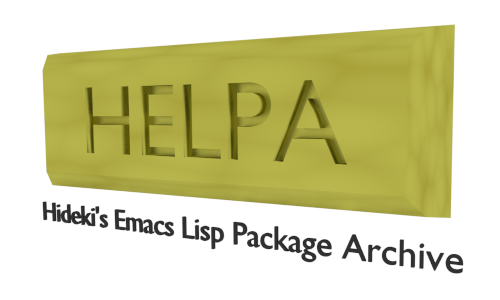
Package Contents
The following packages are currently available at the HELPA
Anti-Space Invader
Summary
Eradicates two spaces after period into single space
Background
Either one-space after period and single space after period are correct in sentence spacing. This script will make a life easier for those using single space when they come across documents prepared using two-spaces.
Limitations
This is simple search and replace, so it does not detect cases that such two-space after period usage may be legit. (Also, reverse conversion is not simple.)
References
- http://en.wikipedia.org/wiki/Sentence_spacing
- http://www.slate.com/articles/technology/technology/2011/01/space_invaders.html
Create Random Buffer
Summary
Creates an empty buffer with random numbered name.
Background
Just wanted to make extra “scratch” buffer.
Limitations
Does not handle buffer name collision.
Requires
- Emacs 24.1 or later
Org Auxiliary Functions
Summary
Org Auxiliary Functions
Text Sanitizing Script
Summary
A simple script that sanitizes text
Background: Certain CMS system I use causes encoding issue when certain character, which would appear when original texts are prepared using word processor softwares. This script removes those texts with acceptable ones.
Function
Replaces unusable texts.
UTF-32 Support for Emacs
Summary
UTF-32 support for Emacs
Original code by
Modifications
Changed name of each coding system so it is consistent with the rest.
UUID Generation Script
Summary
Based on http://ergoemacs.org/emacs/elisp_generate_uuid.html. Some function names are updated to fit my preference.
Dynamic Macro
Summary
Dynamic Macro system.
This version is modified with English version text.
Post installation setup
This script requires post installation setup.
Add something like the following in your .emacs (or your initialization script.)
You can specify your own choice of key mapping to invoke this feature.
(defconst *dmacro-key* "\C-t" "Repeat Key") (global-set-key *dmacro-key* 'dmacro-exec) (autoload 'dmacro-exec "dmacro" nil t)
How does this work?
tl;dr Type in some text and by pressing pre-determined key (Ctrl-T for the above setup) and your Emacs will execute what it think is the repeat of what you have previously done.
dmacro.el predicts user’s repeated input to predict the following input. *dmacro-key* defines “repeat key” which predicts detection and execution of the repeated commands.
For instance if the user type: abcabc and then press the “repeat key” and dmacro.el detects the repeated input of “abc” and then the resulting text will show: abcabcabc Another example, if the user type: abcdefab and then press the “repeat key” then dmacro.el determines this as a repetition of “abcdef” which completes the rest of the string, making the resulting text: abcdefabcdef Pressing the “repeat key” will cause the text will repeat “abcdef” making the resulting text: abcdefabcdefabcdef
All key inputs are considered and executed for example, given:
line1
line2
line3
line4
and then changing the above to:
% line1
% line2
line3
line4
and pressing “repeat key” will update the text:
% line1
% line2
% line3
line4
As you can see above, it will add “%” every time the “repeat key” is pressed.
You can think of this as if the keyboard macro is determined automatically by recognizing repeat pattern. Normally the keyboard macro requires user to specifically define them prior to their execution, but dmacro.el can execute such command even after the user realizes that he/she wants to repeats the previous input. Also the method of defining macro is simplified compared to the keyboard macro, which the user has to define begin/end of the macro.
Use examples
String replace
We’ll think of an example where you want to replace “abc” to “def.” Typical key input for searching “abc” is “Ctrl-S a b c ESC” and it can be replaced to “DEL DEL DEL d e f” to replace it to “def.” By pressing “repeat key” after the input of “Ctrl-S a b c ESC” the user can press the “repeat key” resulting “DEL DEL DEL d e f” is predicted to replace next “abc” with “def” as a result. Continuing to press the “repeat key” will change the next “abc” into “def” as well. Like the example above, “repeat key” can be used to sequentially replace strings one after another.
Drawing using lines
Repeating pattern can be drawn easily, for example:
─┐┌┐┌┐┌┐┌┐┌┐┌┐┌┐┌┐┌┐┌┐┌┐┌┐┌┐ └┘└┘└┘└┘└┘└┘└┘└┘└┘└┘└┘└┘└┘You can use scripts like keisen.el and draw:
─┐┌┐ └┘press the “repeat key” will make it:
─┐┌┐ └┘└┘and pressing “repeat key” will update it:
─┐┌┐┌┐ └┘└┘└┘Another example:
┌─┐┌─┐┌─┐┌─┐┌─┐┌─┐┌─┐┌─┐ └─┘└─┘└─┘└─┘└─┘└─┘└─┘└─┘the drawing above can be created by just having the following:
┌─┐ ─ └─┘then pressing the “repeat key” as needed.
Method of predicting repetition
There are many way to predict inputs, but dmacro.el prioritize this as the following:
(1) If there is a pattern that repeats twice immediately prior to the input of the “repeat key” then prioritize that. If there are multiple patterns that are repeating, prioritize the longer one. For the input of “teetee” it is possible to interpret this as repetition of “tee” or “ee” but in this case, it uses “tee” as a repetition.
(2) Without meeting the condition (1) previous input s is a part of the previous string, such as s t s then it will predict t first, then s t. At this time, it prioritize the longest s then the shortest t within.
For example “abracadabra” the longest one is s=“abra” the prediction will be s t=“cadabra” as a prioritized detection.
XEmacs compatibility, Super, Hyper, Alt key compatibility
This version supports XEmacs. Currently, it is tested with GNU Emacs 18, 19, 20, 21 XEmacs 21. Previous dmacro did not support Super, Hyper, Alt keys but this version supports these keys. It is possible to set *dmacro-key* to Super, Hyper, Alt, Meta but the following should be noted:
*dmacro-key* designation
For GNU Emacs
- For using Control as Modifier key only, it is possible to specify “\C-t” as a string. But [?\M-t], [?\s-t], [?\H-t], [?\A-t] should be used for Meta, Super, hyper, Alt respectively.
For XEmacs
- The limitation does not above does not apply. It is possible to specify keys, for example [(super t)] for Super key.